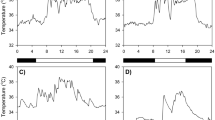Abstract
The effects of environmental temperature and photoperiod on wheelrunning activity were studied in the diurnal red squirrel,Tamiasciurus hudsonicus. From 1 July to 22 November 1973 eight squirrels were maintained in separate cages in an outdoor shelter. Activity usually began before sunrise in the summer an early fall and after sunrise in the late fall. Wheel-running usually persisted throughout the day and ceased about the time of sunset in the summer and early fall. In late fall cessation frequently occurred after sunset. Neither changes in temperature nor photoperiod were found to separately account for the seasonal changes. Multiparameter analysis of variance was found to be a powerful statistical tool for analyzing the data. Six models for predicting the onset of activity were constructed and tested.
Similar content being viewed by others
References
ASCHOFF, J. (1964): Die Tagesperiodik licht- und dunkelaktiver Tiere. Rev. suisse Zool., 71: 528–558.
ASCHOFF, J. (ed.) (1965): Circadian Clocks. North-Holland Publ. Comp., Amsterdam.
ASCHOFF, J. (1969): Phasenlage der Tagesperiodik in Abhängigkeit von Jahreszeit und Breitengrad. Oecologia (Berl.), 3: 125–265.
BAHNAK, B. (1975): Influence of seasonal factors on the activity of the red squirrel,Tamiasciurus hudsonicus, M.S. Thesis, Michigan Technological University, Houghton.
CHAUVNICK, A. (ed.) (1960): Biological clocks. Cold Spr. Harb. Symp. quant. Biol., 25, pp. 524.
CLARKSON, D. and FERGUSON, J. (1972): Environmental temperature versus spontaneous running-wheel activity in the red squirrel,Tamiasciurus hudsonicus. Int. J. Biometeor., 16: 269–276.
CLOUDSLEY-THOMPSON, J. L. (1961): Rhythmic Activity in Animal Physiology and Behaviour. Academic Press, London and New York.
DAAN, S. and ASCHOFF, J. (1975): Circadian rhythms of locomotor activity in captive birds and mammals: their variations with season and latitude. Oecologia (Berl.), 18: 269–316.
DECOURSEY, P. (1960): Phase control of activity in a rodent. Cold Spr. Harb. Symp. quant. Biol. 25, 49–56.
DECOURSEY, P. (1972): LD ratios and the entrainment of circadian activity in a nocturnal and a diurnal rodent. J. comp. Physiol., 78: 221–235.
DOUCET, G., BIDER, J. (1974): The effects of weather on the activity of the masked shrew. J. Mamm., 55: 348–363.
ENRIGHT, J. (1966): Influences of seasonal factors on the activity onset of house finches. Ecology, 47: 662–666.
ESKIN, A. (1969): The sparrow clock: behavior of the free-running rhythm and entrainment analysis. Ph.D. Thesis, University of Texas, Austin.
KAVANAU, J. and PETERS, C. (1976): Activity of nocturnal primates: influences of twilightzeitgebers and weather. Science, 191: 83–86.
KRAMM, K. (1973): Photoperiod and entrainment of circadian activity in the antelope ground squirrel. BioScience, 23: 516–522.
KRAMM, K. (1975a): Entrainment of circadian activity rhythms in squirrels. Amer. Natur., 109: 379–389.
KRAMM, K. (1975b): Circadian activity of the red squirrel,Tamiasciurus hudsonicus, in continuous darkness and continuous Illumination. Int. J. Biometeor., 19: 232–245.
LAYNE, J. (1954): The biology of the red squirrel,Tamiasciurus hudsonicus loquax (Bangs) in central New York. Ecol. Monogr., 24: 227–267.
MARTEN, G. (1973): Time patterns of Peromyscus activity and their correlations with weather. J. Mamm., 54: 169–185.
MEDENHALL, W. (1968): The Design and Analysis of Experiments. Wadsworth Publ. Comp., Belmont, California.
MENAKER, M. (ed.) (1971): Biochronometry. National Academy of Sciences, Washington, D. C., pp. 662.
MISELIS, R. and WALCOT, C. (1970): Locomotor activity rhythms in homing pigeons (Columba livia). Anim. Behav., 18: 544–551.
ZWAHLEN, R. (1975): Die locomotorische Activität des Eichhörnchens (Sciurus vulgaris). Oecologia, 22: 79–98.
Author information
Authors and Affiliations
Additional information
This publication is based on a Master's thesis by B. R. Bahnak.
Rights and permissions
About this article
Cite this article
Bahnak, B.R., Kramm, K.R. The influence of environmental temperature and photoperiod on activity in the red squirrel,Tamiasciurus hudsonicus . Int J Biometeorol 21, 348–356 (1977). https://doi.org/10.1007/BF01555196
Received:
Issue Date:
DOI: https://doi.org/10.1007/BF01555196




